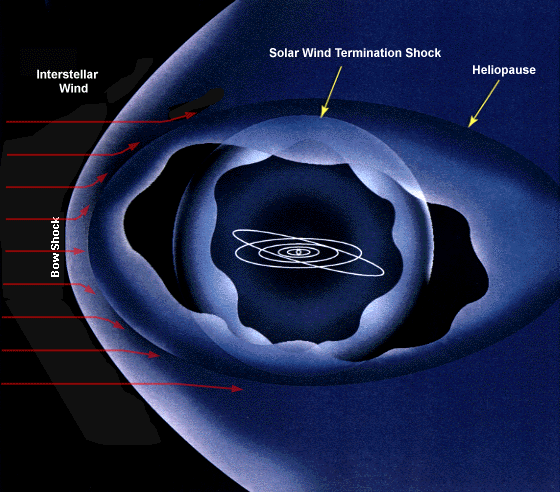The heliosphere is often described as a kind of bubble that contains our solar system. This magnetic sphere, which extends beyond Pluto, is caused by the Sun’s solar winds. These winds spread out from the Sun at around 400 km/s until they hit what is known as interstellar space, which is also called local interstellar medium (LISM) or interstellar gas. Interstellar space is the space in galaxies that is unoccupied by either stars or planets.
When the solar winds hit local interstellar medium, a kind of bubble forms that prevents certain material from getting in. Thus, the heliosphere acts as a kind of shield that protects our solar system from cosmic rays, which are dangerous interstellar particles. The interaction between interstellar gas and solar winds depends on the pressure of the solar winds and properties of interstellar space, such as pressure, density, and qualities of the magnetic field. Astronomers believe that other solar systems have their own heliospheres caused by different stars.
There are several different parts of the heliosphere. The heliopause is the boundary between the heliosphere and the LISM. When solar winds approach this blurred region, they slow abruptly causing a shock wave to form known as the solar wind termination shock. The action is similar to slamming down on the brakes in a car, causing people and objects in the car to fly forward. This shock wave actually causes the particles to accelerate, aiding in the formation of the heliosphere. After it has slowed down, the winds of interstellar space act on the solar winds causing them to curve forming what has been described as a comet-like tail to the Sun. This tail, which has been examined by NASA’s probes Voyager 1 and Voyager2, is called the heliosheath. The termination shock is from around 75 to 90 astronomical units (AU) from our Sun, and at its closest point, the heliosheath is approximately 80 to 100 AU from the Sun.
Astronomers monitoring the Sun have noticed that solar winds have decreased to all-time lows. This affects the heliosphere, which in turn can affect Earth and other planets in the solar system. With solar winds lessening, astronomers fear that the strength of the heliosphere will also decrease, leaving our solar system vulnerable to dangerous cosmic rays. Because solar winds are cyclical, some scientists believe that instead of permanently decreasing, the solar winds are merely experiencing a lengthy low period.
We have written many articles about the heliosphere for Universe Today. Here’s an article about how NASA’s STEREO spacecraft has mapped the heliosphere, and another article about how the heliosphere has been shrinking recently.
Here are two other articles from NASA on heliophysics and the heliosphere.
We’ve recorded a special episode of Astronomy Cast about this topic, Episode 65: The End of Our Tour Through the Solar System.
References:
NASA Solar Science: The Solar Wind
NASA Science: The Heliosphere

